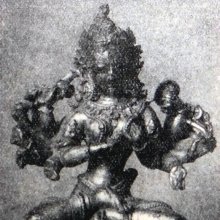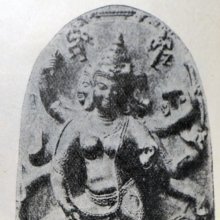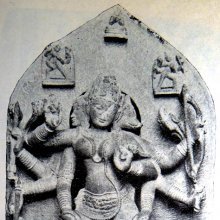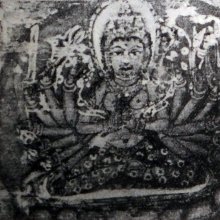Bhindipala, Bhiṇḍipāla, Bhindipāla: 12 definitions
Introduction:
Bhindipala means something in Hinduism, Sanskrit, Jainism, Prakrit. If you want to know the exact meaning, history, etymology or English translation of this term then check out the descriptions on this page. Add your comment or reference to a book if you want to contribute to this summary article.
Images (photo gallery)
(+2 more images available)
In Hinduism
Dhanurveda (science of warfare)
Source: Wisdom Library: DhanurvedaBhindipāla (भिन्दिपाल) refers to a weapon (a short javelin or arrow thrown from the hand or shot through a tube). It is a Sanskrit word defined in the Dhanurveda-saṃhitā, which contains a list of no less than 117 weapons. The Dhanurveda-saṃhitā is said to have been composed by the sage Vasiṣṭha, who in turn transmitted it trough a tradition of sages, which can eventually be traced to Śiva and Brahmā.

Dhanurveda (धनुर्वेद) refers to the “knowledge of warfare” and, as an upaveda, is associated with the Ṛgveda. It contains instructions on warfare, archery and ancient Indian martial arts, dating back to the 2nd-3rd millennium BCE.
Purana and Itihasa (epic history)
Source: Wisdomlib Libary: The Brahmāṇḍa-purāṇaBhindipāla (भिन्दिपाल) refers to a “short javelin thrown with hand” and represents one of the various weapons equipped by the Daityas in their war against Lalitā, according to the Brahmāṇḍa-purāṇa 4.22. Accordingly, “[...] thereupon, crores of Daityas producing reverberating chattering noise furiously prepared themselves (to fight) against Parameśvarī (Lalitā). [...] Crores of Daityas were fully equipped with coats of mail and had the following weapons and missiles in their hands [viz.: Bhindipālas (a short javelin thrown with hand)], and thousands of similar weapons and missiles very dreadful and capable of destroying living beings”.

The Purana (पुराण, purāṇas) refers to Sanskrit literature preserving ancient India’s vast cultural history, including historical legends, religious ceremonies, various arts and sciences. The eighteen mahapuranas total over 400,000 shlokas (metrical couplets) and date to at least several centuries BCE.
General definition (in Hinduism)
Source: Wisdom Library: HinduismBhiṇḍipāla (भिण्डिपाल) is a Sanskrit word translating to “hand javelin”.
In Jainism
General definition (in Jainism)
Source: archive.org: TrisastisalakapurusacaritraBhindipāla (भिन्दिपाल) refers to “javelin” or “sling”, according to chapter 2.2 [ajitanātha-caritra] of Hemacandra’s 11th century Triṣaṣṭiśalākāpuruṣacaritra: an ancient Sanskrit epic poem narrating the history and legends of sixty-three illustrious persons in Jainism.—(cf. Abhidhānacintāmaṇi 3.449)
Accordingly: “Sagara put in his heart archery and the characteristics of other weapons just from hearing them, as easily as his own name. He attained skill in fighting with the bow, sword and shield, dagger, arrow, axe, lance, javelin (i.e., bhindipāla), club, kampaṇa (?), staff, spear, pike, plow-share, mace, cudgel, pattiṣa, duḥsphoṭa (?), bhuṣaṇḍhī sling, arrow, trident, dart, and other weapons in conformity with the manuals. He became filled with all the arts like the full moon with digits, and he was adorned with good qualities, reverence, etc., like ornaments”.
Note: In I, n. 76, bhindipāla is interpreted as “sling”, in accordance with its meaning in M and H. PH, with ref. to Praś and Jiv., defines it as ‘knife’ or ‘dagger’. For other interpretations, see the lexicons and Meyer, p. 153, whose com. says it is “like a kunta with a broad point”. Agnipurāṇa 251.15 compares it with a laguḍa.

Jainism is an Indian religion of Dharma whose doctrine revolves around harmlessness (ahimsa) towards every living being. The two major branches (Digambara and Svetambara) of Jainism stimulate self-control (or, shramana, ‘self-reliance’) and spiritual development through a path of peace for the soul to progess to the ultimate goal.
Languages of India and abroad
Sanskrit dictionary
Source: DDSA: The practical Sanskrit-English dictionaryBhindipāla (भिन्दिपाल).—
1) A small javelin thrown from the hand; वानरान् भिन्दिपालैश्च शूलैश्चैव व्यदारयन् (vānarān bhindipālaiśca śūlaiścaiva vyadārayan) Rām.6.42. 45.
2) A sling, an instrument like a sling for throwing stones; उत्काबाणैश्च शतशः भिन्दिपालैश्च भूरिशः (utkābāṇaiśca śataśaḥ bhindipālaiśca bhūriśaḥ) Śiva B. 14.2; भिन्दिपालासिपट्टिशैः (bhindipālāsipaṭṭiśaiḥ) Parṇāl.4.76.
Derivable forms: bhindipālaḥ (भिन्दिपालः).
See also (synonyms): bhindapāla.
Source: Cologne Digital Sanskrit Dictionaries: Edgerton Buddhist Hybrid Sanskrit DictionaryBhiṇḍipāla (भिण्डिपाल).—m. (compare Sanskrit Lex. and AMg. bhiṇḍimāla), = Sanskrit bhindipāla, a kind of missile weapon: Mahāvyutpatti 6103 = Tibetan mtshon rtse gcig pa, one-pointed dart.
Source: Cologne Digital Sanskrit Dictionaries: Shabda-Sagara Sanskrit-English DictionaryBhindipāla (भिन्दिपाल) or Bhindapāla.—m.
(-laḥ) 1. A short arrow thrown from the hand, or shot through a tube. 2. A sling, a string-instrument for throwing stones. E. bhidi-in bhindi, pāli-an .
Source: Cologne Digital Sanskrit Dictionaries: Cappeller Sanskrit-English DictionaryBhindipāla (भिन्दिपाल).—[masculine] a kind of spear.
Source: Cologne Digital Sanskrit Dictionaries: Monier-Williams Sanskrit-English DictionaryBhindipāla (भिन्दिपाल):—m. a short javelin or arrow thrown from the hand or shot through a tube (others ‘a stone fastened to a string’ or ‘a kind of sling for throwing stones’), [Mahābhārata; Rāmāyaṇa etc.] ([varia lectio] bhindapāla, BiRqimAlA, bhindomāla, bhindimāla or laka, bhindumāla).
Source: DDSA: Paia-sadda-mahannavo; a comprehensive Prakrit Hindi dictionary (S)Bhindipāla (भिन्दिपाल) in the Sanskrit language is related to the Prakrit words: Bhiṃḍimāla, Bhiṃḍavāla.
[Sanskrit to German]
Sanskrit, also spelled संस्कृतम् (saṃskṛtam), is an ancient language of India commonly seen as the grandmother of the Indo-European language family (even English!). Closely allied with Prakrit and Pali, Sanskrit is more exhaustive in both grammar and terms and has the most extensive collection of literature in the world, greatly surpassing its sister-languages Greek and Latin.
See also (Relevant definitions)
Starts with: Bhindipalaka.
Ends with: Panditakarabhindipala.
Full-text (+23): Bhindapala, Pindipala, Bhindimala, Bhindumala, Bhindamala, Sriga, Bhimdavala, Bhindivala, Kalagni, Kapala, Bhishana, Samhara, Sarvajna, Yogisha, Unmatta, Varada, Trinetra, Mukhara, Sarvabhutahridisthita, Maharaudra.
Relevant text
Search found 15 books and stories containing Bhindipala, Bhiṇḍipāla, Bhindipāla; (plurals include: Bhindipalas, Bhiṇḍipālas, Bhindipālas). You can also click to the full overview containing English textual excerpts. Below are direct links for the most relevant articles:
Nitiprakasika (Critical Analysis) (by S. Anusha)
Bhindipāla (Crooked Club) < [Chapter 3]
Laguḍa (Club) < [Chapter 3]
Sarga IV: Muktāyudha-nirūpaṇa (52 Verses) < [Chapter 2]
The Skanda Purana (by G. V. Tagare)
Chapter 17 - The Fight between Yama and Grasana < [Section 2 - Kaumārikā-khaṇḍa]
Chapter 171 - Battle between Vasiṣṭha and Viśvāmitra < [Section 1 - Tīrtha-māhātmya]
Chapter 19 - Demon Mahiṣa Slain by Durgā < [Section 3b - Arunācala-khaṇḍa (Uttarārdha)]
The Shiva Purana (by J. L. Shastri)
Chapter 48 - Swallowing of Śukra < [Section 2.5 - Rudra-saṃhitā (5): Yuddha-khaṇḍa]
Chapter 20 - The destruction of Dakṣa’s sacrifice (1) < [Section 7.1 - Vāyavīya-saṃhitā (1)]
Harshacharita (socio-cultural Study) (by Mrs. Nandita Sarmah)
Part 9.4: Weapons of the War < [Chapter 5 - Political Aspects]
Ramayana of Valmiki (by Hari Prasad Shastri)
Chapter 86 - Indrajita breaks off his Sacrifice to fight with Lakshmana < [Book 6 - Yuddha-kanda]
Chapter 21 - Ravana goes to the Nether Regions to challenge Yama < [Book 7 - Uttara-kanda]
Chapter 96 - Ravana goes out to fight and encounters ill Omens < [Book 6 - Yuddha-kanda]
The Agni Purana (by N. Gangadharan)





